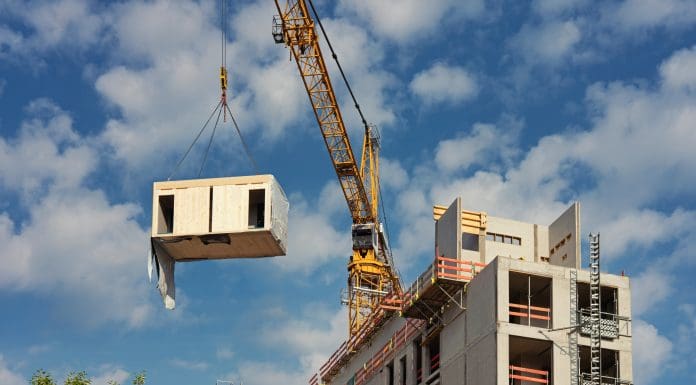
Tim Barrett, chair of Construction Alliance North East, explores Modern Methods of Construction (MMC) and Sustainability
In recent years, the construction industry has witnessed a significant shift towards the adoption of Modern Methods of Construction (MMC), driven by technological advancements, the need for efficiency and the growing emphasis on sustainability.
Conventional construction methods, while time-tested, have often been criticised for their inefficiency, wastefulness and environmental impact. In contrast, MMC focuses on improving construction practices by leveraging innovative techniques, materials and technologies, while aligning with the global push towards sustainability.
The environmental benefits of MMC
The construction industry is one of the largest contributors to global environmental degradation. From energy consumption during building operations to the depletion of raw materials, traditional construction methods have been highly resource intensive. MMC, on the other hand, offers several environmental advantages that can significantly reduce the industry’s impact on the planet.
Waste reduction
One of the major environmental benefits of MMC is the reduction of construction waste. Traditional construction methods often generate large amounts of waste due to on-site cutting, handling, and inefficiencies. However, with MMC, materials are often pre-measured, pre-cut, and pre-assembled in factory-controlled environments, which significantly reduces material waste.
Additionally, waste generated during off-site manufacturing can be recycled more effectively. For example, modular construction allows for better planning and optimisation, resulting in fewer mistakes and less scrap material. In some cases, even the modules can be disassembled and reused, further contributing to a circular economy in construction.
Energy efficiency
Energy consumption during construction and building operation is another critical area of concern for the environment. MMC methods are designed to be more energy-efficient during the building phase. Prefabrication, for example, allows for precise control over the materials used and the energy efficiency of the components being constructed. Building components such as walls, roofs, and floors can be designed with improved insulation, reducing the need for additional heating or cooling once the building is completed.
Modular homes and buildings are also known for their energy efficiency, thanks to their airtight construction and superior thermal insulation. These features reduce energy consumption and make the building more sustainable over its lifetime.
Reduced carbon footprint
Sustainability in construction is not only about minimising waste and energy consumption but also about reducing the carbon footprint of buildings. The production of traditional building materials like concrete and steel generates significant greenhouse gas emissions. In contrast, MMC methods often utilise materials that are more sustainable.
For example, cross-laminated timber (CLT) has gained prominence in sustainable building projects. Wood is a renewable resource that can be grown and harvested sustainably. Furthermore, CLT acts as a carbon sink, sequestering carbon dioxide throughout the life of the building. Using timber in construction can reduce the reliance on high-emission materials like concrete and steel, leading to a lower overall carbon footprint.
Faster construction times
The quicker construction times enabled by MMC methods also contribute to sustainability. Shorter construction timelines reduce the amount of energy used during the building phase, as well as the environmental impact of on-site construction activities. Furthermore, faster construction means that buildings can be operational sooner, allowing occupants to begin saving energy and reducing emissions earlier.
Sustainability through building design and performance
Sustainability is not just about how buildings are constructed but also how they perform throughout their lifecycle. MMC often incorporates energy-efficient designs, renewable energy systems, and materials that are both sustainable and durable. The focus is on reducing a building’s operational environmental impact, which can be as important, if not more so, than the impact of construction.
Smart building technologies
Modern buildings often incorporate smart technologies that enhance their sustainability. Automated systems for heating, ventilation, air conditioning (HVAC) and lighting can reduce energy consumption by adjusting according to occupancy levels and weather conditions. These systems are typically integrated into MMC, making it easier to design energy-efficient buildings that perform optimally throughout their lifecycle.
For example, smart grids and energy storage systems can be integrated into buildings to optimise energy usage and even allow for the use of renewable energy sources like solar panels and wind turbines. As smart technologies evolve, they will enable buildings to become more self-sufficient, contributing to a reduction in overall environmental impact.
Renewable energy integration
Another critical aspect of sustainable construction is the integration of renewable energy sources. Buildings constructed using MMC often come with the infrastructure to support solar panels, wind turbines, or geothermal systems. Since MMC focuses on off-site manufacturing, there is more flexibility in incorporating these sustainable technologies early in the design phase, making it easier to plan for energy-efficient and self-sustaining buildings.
Modular homes and buildings can be fitted with solar panels or other renewable energy systems with minimal disruption, making them even more sustainable in the long term.
The challenges of Modern Methods of Construction and sustainability
While MMC offers significant environmental benefits, there are still challenges to be addressed in fully realising its potential.
Initial costs and financial barriers
One of the primary challenges of adopting MMC is the initial cost. Although MMC can be more cost-effective in the long run due to shorter construction times and reduced waste, the upfront investment can be higher compared to traditional construction. For example, the technology and materials used in modular construction or 3D printing may require more capital investment at the start of a project.
Additionally, the widespread adoption of MMC often requires retraining workers and adapting existing infrastructure, which can be costly. The financial barriers to adopting these methods may be a deterrent for some developers, particularly in regions where traditional construction is more deeply ingrained.
Supply chain constraints
MMC often relies on specialised materials, components and systems produced in controlled environments or factories. However, this can create challenges with supply chains, especially when demand for certain materials or components exceeds supply. As the adoption of MMC grows, supply chains will need to be expanded and streamlined to meet the demand for specialised construction materials.
Regulatory and planning constraints
In many regions, building codes and regulations are still based on traditional construction methods. Adapting these regulations to accommodate new methods of construction can take time and may require significant policy changes. The process of getting approvals for innovative MMC projects can be complex, and developers may face resistance from regulatory bodies unfamiliar with the methods.
A sustainable future for construction
Modern Methods of Construction offer significant potential to transform the construction industry, particularly in terms of sustainability. The benefits of MMC, such as waste reduction, energy efficiency, reduced carbon footprints and faster construction times, align well with the growing need for environmentally responsible building practices. While there are challenges to overcome, the ongoing advancements in technology, materials, and processes will likely continue to drive the evolution of MMC, leading to a more sustainable and efficient future for construction.
By embracing MMC, the construction industry can make significant strides in reducing its environmental impact, contributing to the global efforts to mitigate climate change. Sustainable construction practices are no longer a luxury but a necessity, and MMC is at the forefront of this important transformation.
The post Why use Modern Methods of Construction? appeared first on Planning, Building & Construction Today.

